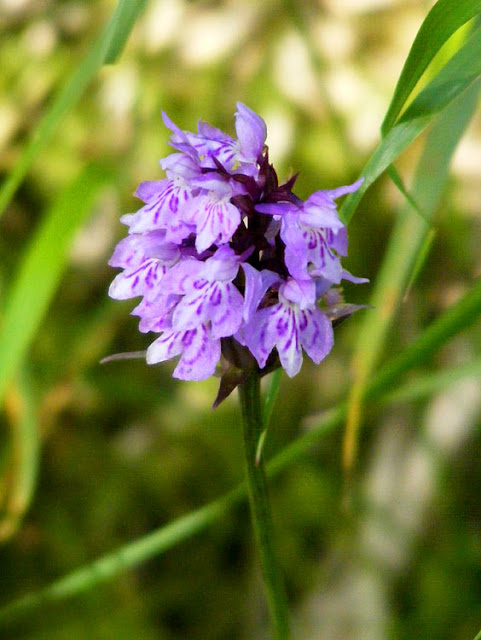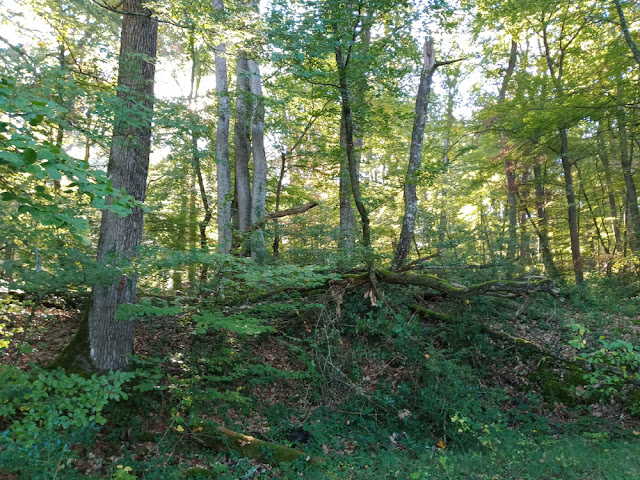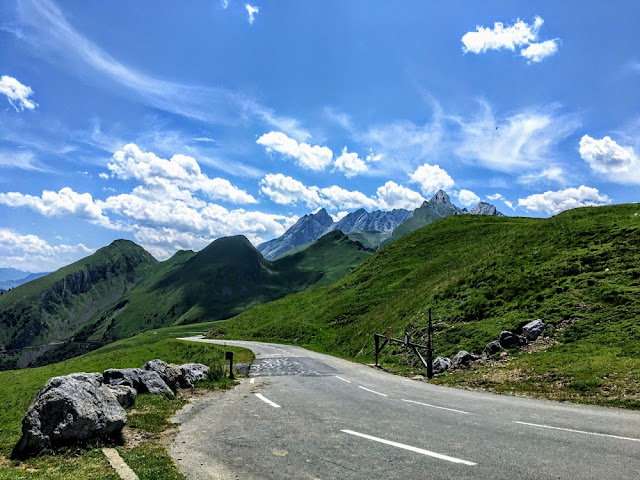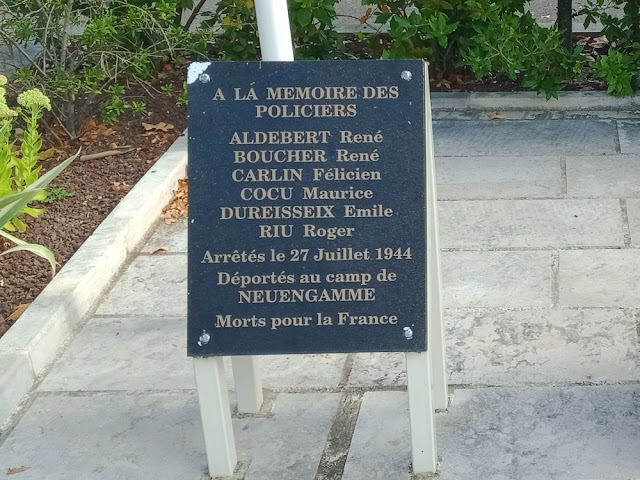Saturday, 31 August 2024
Plane on a Stick
Friday, 30 August 2024
French Red Underwing
A few evenings ago Simon called out to me 'Quick! there's a huge moth in the laundry. Get the camera!' My first thought, if it was really huge is that it would be a Convolvulus Hawk Moth, especially since one had leapt out of my swimming bag when I opened in the changing room a few days earlier. It must have been on my towel on the line, got folded up, and only escaped when I unzipped the bag.
But it turned out to be a red underwing moth, and subsequent requests to mothing friends indicated that it was specifically a French Red Underwing Catocala elocata (Fr. la Déplacée).
French Red Underwings are found in central and southern Europe, Turkey, Uzbekistan and Kazakhstan. They are the biggest of the ten red underwing moth species that can be found in France, with wingspans of 80 mm. The adults fly from July to October, in wooded habitats, including towns and villages. The caterpillars eat the leaves of poplars, or sometimes willows.
This species can be very easily confused with the Red Underwing C. nupta. There is a very good comparison photo and list of characters to check on Lépi'Net if you ever need to distinguish between the two.
French Red Underwings are warmth loving creatures that live along the banks of rivers. But they are very commonly encountered in urban locations too. They will occasionally be attracted by a light, but usually quickly back off and sit motionless in the shadows, exactly as happened in our laundry.
It does not appear to be threatened, as it favours landscapes which are stable and very common caterpillar host plants.
Thursday, 29 August 2024
One of Darwin's Mysteries Solved
Charles Darwin, that global household name, loved orchids and was intrigued by their many mysteries. He famously predicted that an unknown hitherto unobserved species of long tongued moth must be the nocturnal pollinator of the orchid Angraecum sesquipedale, a species with a particularly lengthy nectar carrying spur, endemic to Madagascar.
But one mystery, much closer to home, eluded him, and has only recently been solved. It concerns one of the most common wild orchids in Britain. We get it too in the Touraine Loire Valley but here it is not common, especially in the south where we live. I find it more on our travels especially in the mountains.
What Darwin never figured out was why the Common Spotted Orchid Dactylorhiza fuchsii (Fr. Orchis de Fuchs) is not scattered about everywhere. After all, their seeds are nearly microscopically small and can be easily dispersed by the wind. In the end though, it is their tiny size which provides the clue as to why Common Spotted Orchids grow in clumps and close knit colonies rather than in the more isolated and scattered way that one might at first think should be the case.
Common Spotted Orchid seeds are so small that they don't contain the supply of nutrients that the seeds of other plants tend to hold. That means to survive they must fall near enough to their parent plant to latch on to its network of mycorrhizal fungi, which will then supply the necessary nutrients. Common Spotted Orchids can be seen in large dense colonies, but few of the individual plants will be more than a few centimetres from an older, more established plant.
Further Reading: Dactylorhiza fuchsii on Loire Valley Nature
Wednesday, 28 August 2024
Taking Care of the Forests
Smoke from the Gironde fires photographed in Libourne when we stopped for lunch in July 2022.
Tuesday, 27 August 2024
Walking From Chaumussay
Here are some photos from a walk I took on a fairly hot day in August. It was two and a half kilometres around Chaumussay, and took me half an hour.
European Peacock Inachis io (Fr. Paon-du-jour) and Red Admiral Vanessa atalanta (Fr. Vulcain) butterflies nectaring on Hemp-agrimony Eupatorium cannabinum (Fr. Eupatoire à feuilles de chanvre) by the side of the greenway (Fr. voie verte).
Naturalised apple tree by the side of the voie verte.
Soapwort Saponaria officinalis (Fr. Saponaire), a wild plant once used to make suds to wash hands and delicate embroidery and lace in the Touraine.
The village church.
A charming garden gate, made by Michel for his house in the village.
This rose was feeling the heat.
Public planting at the end of the bridge.
Monday, 26 August 2024
Ronsard's Melons
The modern variety of Charentais melon, with its yellow netted skin and green ribs, was developed in the Poitou-Charente area, just to our south-west, in the 1920s, but the original Charentais Melon goes back to the 15th century, brought here by Charles VIII as a prize from his Italian campaign. He had them grown in the Touraine Loire Valley, close to the many chateaux which were now serving as luxury country residences for the King and his courtiers. By the 16th century the court poet, Pierre de Ronsard, was moved to write a hommage to eating melon in the summer by the side of a stream.
Pierre de Ronsard, regarded as "the Prince of poets and the poet of Princes", was Prior of the Priory of St Cosme from 1565 to 1585.
Pierre de Ronsard's private apartments at the Prieuré de Saint Cosme.
Pompons (or pepons), imported from Italy during the Renaissance, are melons that Ronsard, a keen gardener, grew himself at the Prieuré de Saint-Cosme. Behind his house, built in 1348, there is an 'exotic' kitchen garden dedicated to Ronsard's taste for the new fruits and vegetables that were appearing in France at the time. In 1565, Ronsard offered a basket of his melons to the royal family (Charles IX and Queen Mother Catherine de Medici), who were stopping off at the nearby château du Plessis-Lès-Tours, with this poem for the occasion:
Vous qui semblez de façons et de gestesAux immortels, imitant les Célestes,Prenez de moi ces pompons et ces fruits.Les-vous offrant, je ne crains que personneBlâme mon don : car, Sire, je vous donneNon pas beaucoup, mais tout ce que je puis.
A la Reine, Pierre de Ronsard, 1565
Saturday, 24 August 2024
Col d'Aubisque
Friday, 23 August 2024
1000 Years
As I mentioned on Saturday, last weekend the de Becdelièvre family celebrated 1000 years of living in the chateaux of Boussay. The first hundred years was in a wooden chateau - until the Vikings burnt it to the ground. They rebuilt in stone, and parts of that chateau still stand. A couple of rebuilds and many alterations later and we have the building that exists today.
We went to view the son et lumière on Sunday night. Here are some of the images (in no particular order). They were all taken on my Fujifilm HS10 camera at f/3.6 • ¼ second exposure • ISO 800 • and the camera was hand held.
Thursday, 22 August 2024
Street Art in Preuilly
Gérald's been at it again. More artwork has appeared on the front of his house. He and Françoise live in the house once owned by our friends the Lartigau family, at the top of our street.
Gérald's first artwork on the facade of the house, completed a couple of months ago.
Several generations of Lartigaus had lived there, and they were tailors. When Mme Lartigau died her grandchildren inherited the house. Their lives were elsewhere and they decided to sell the house. Gérald and Françoise purchased, and really we could not wish for better neighbours.
This is what the house currently looks like.
Over the last few months Gérald has been adding artwork to the facade, in a charming acknowledgement of the past. He is well aware of its history, and aware it is a bit sad that the Lartigau family is not there any more. It would have been different if Jean-Pierre Lartigau had lived, but he succumbed to colon cancer in 2011 [here's a link to my obituary of him].
Gérald's latest artwork, completed a couple of weeks ago.
Wednesday, 21 August 2024
Le Rafle de Loches
The French word 'rafle' means 'police roundup' in English. Because of its associations with the mass arrests of the Second World War, most famously the Rafle du Vel d'Hiv, it is quite a toxic term.
On 27 July 1944, at dawn, a German task force from Tours, accompanied by Gestapo agents and French members of the collaborationist parties (fascists, anti-semites or anti-Bolsheviks mostly), stormed the sub-prefectural town of Loches.
Memorial plaque to the clerk of the court, one of the victims of the roundup.
They arrested everyone they encountered in the street, including the sub-prefect, and went to their homes to look for anyone suspected of being more or less active in helping the Resistance.
Among them were civilians such as Marguerite Mallet, wife of Raymond Mallet, one of the leaders of the Secret Army of Loches, Lucienne and René Tocheport, factory owners whose trucks were used by the maquisards, Odette Houlbreque, a nurse who was very close to the maquis leader Lecoze, and Ernestine Denise Charlot, a milliner in rue Quintefol whose nephew had just joined the maquis of Épernon.
Memorial plaque to police officers who died in concentration camps after the roundup.
They also arrested all the members of the police and thirty-six gendarmes present in Loches, who they reprimanded for their lack of diligence in the search for young men who had refused to join the STO (the compulsory labour service which deported those forced to join to Germany to work in the mines and factories). Since 12 June 1944, all the gendarmes of the brigades of the Loches section had, by order of their senior officers, been assembled at the chief town. So that is, in addition to the gendarmes of the brigade of Loches, those of the brigades of Preuilly-sur-Claise, Montrésor, Saint-Flovier, Boussay, Villeloin-Coulangé and Abilly were all gathered in Loches.
All those arrested, maybe as many as three hundred people, were taken to the courtyard of the girls' school for interrogation.
This war memorial to police officers who lost their lives in the Second World War is in Place des Anciens d'AFN, next to the Agnes Sorel cultural centre in Loches, and the Metropolitan Police Station.
At the end of the day, 58 men and six women (including Mme Mallet) were sent to the Henri Martin prison in Tours before being deported to Germany.
The gendarmes were first sent to the Neuengamme camp where they arrived on 1 September 1944. Some of them stayed there, the others were sent to the Wilhelmshaven Command where 29 of them died.
Denis Louis BONNAUDET: Born in 1906 in Chatonnay (Vendée), he was the Adjutant at the police station in Preuilly. Having not taken any action against the Resistance in the area he was arrested and taken to prison in Tours. He joined a convoy of prisoners from Rennes and was taken to Belfort then Neuengamme and later Wilhelmshaven. He died in April 1945 at Luneburg.
Ernestine Denise CHARLOT: Born in 1886 at Loches, she was a milliner. She was arrested for having sheltered her nephew, who was in the Resistance, following a denunciation by a woman from Loches. Imprisoned in Tours, she joined the Rennes convoy heading for Belfort. She was deported in September 1944 to Ravensbruck concentration camp, where she was gassed in April 1945.
Noel HAPPE: Born on Christmas Day in 1918 at Hellendoom in the Netherlands, he was a policeman in Preuilly. He was deported via the same route as the others, but only taken as far as Neuengamme. He survived the War and was liberated in the Flensburg Fjord. After the War he wrote a short account of his experience.
Odette HOULBREQUE: Born in 1911 at Fécamp (Seine-Maritime) she was a nurse and close friend of the notorious Resistance leader known as Lecoze (who claimed to be a doctor, but was really just a violent criminal and fraudster on the run). She was sent to Ravensbruck but luckily did not stay there. She was liberated in Hamburg in May 1945.
Marguerite MALLET: Born in 1914 at Lille, she was arrested and sent to Belfort like the others, but after that it is not known what happened to her, and her name is missing from the memorial in Loches. Evidence suggests that she died at Ravensbruck in February 1945. Her husband, a lawyer, was one of the local Resistance leaders and head of the political wing of the Loches based section of the Secret Army.
Lucienne TOUCHEPORT: Born Lucienne Métais in 1907 at Ferriere-sur-Beaulieu, near Loches. She was arrested for having sheltered Resistance members and sent to Ravensbruck by the same route as the others, but then on to another concentration camp and finally Oranienburg, where she was liberated in April 1945.
René TOUCHEPORT: Born in 1906 at Descartes, he was an industrialist, married to Lucienne and living in a charming hamlet just outside of Loches called Les Petites Maisons. He was arrested for sheltering Resistance members and sent to Germany, ending up at Wilhelmshaven and dying there in April 1945.
Paul WATEL: Born in 1914 at Lambersart (Nord), he was a policeman at Preuilly sur Claise. He was deported to Neuengamme, where he died in November 1944.
Tuesday, 20 August 2024
The Trouble with Honey Bees
The trouble with honey bees Apis mellifera (Fr. abeilles des ruches) is that they are a bit like feedlot cattle or battery hens in terms of their impact on the environment. They are not polluting by contributing to greenhouse gases or nitrogen levels in rivers but they are intensively managed animals in enormously large numbers that are significantly and detrimentally altering their immediate environment. Yes, you read that right. Many honey bees are not the good guys, but the bad guys in their neighbourhood.
Honey bees drinking in a stream.
So what exactly is the problem? Surely we need all the pollinators we can get these days? -- that's what the mainstream media is telling us... The problem is that most honey bees are managed intensively, which means that there might be millions of them working over the flowers in a fifty square kilometre patch. By sheer weight of numbers they are out competing the dozens of other species of native bees who do not have the advantage of being cossetted and fussed over by a beekeeper, or the social structure which means that a honey bee colony operates like a single gigantic and voracious foraging entity. Bumble bees form modest colonies of a few hundred members at most, and all the other dozens of wild native bee species are operating as individuals, some of which do not fly more than 150 metres from where they hatched, and who simply cannot survive or reproduce on the dregs left to them if there is a group of honey bee hives placed nearby.
Honey Bee on lavender.
Until recently entomologists and ecologists have only suspected there might have been competition for food that was negatively affecting solitary bees, but since 2017 there have been a number of studies, most of them French, which have shown conclusively that honey bees in numbers above about two to three hives (so around a hundred and fifty thousand individuals maximum) are causing a 'halo effect', where inside a radius of 600 metres from the hives, solitary bee numbers are halved. And that effect continues to some extent for several kilometres, depending on how many hives there are.
A swarming Honey Bee hive.
The problem is compounded because honey bees are good at collecting pollen, but not particularly good pollinators, so both plants and solitary bees are losing out. Modern honey bees are about 20 times as draining on pollen and nectar resources as honey bees from prior to the 1950s. This is in part due to modern managed honey bees being selected and bred for honey production. In addition, one of the primary sources of pollen and nectar for bees of all sorts is wild flower rich grasslands, a habitat which has declined by about 90% since the 1970s.
This many hives indicates a commercial apiarist, or a serious hobbiest who has a sideline in selling honey. The position and time of year indicated that sweet chestnut trees in flower were the target. They make a premium honey.
It is for this reason that ecologists are starting to support the idea that hives should be banned within a 2-3 kilometre cordon around nature reserves.
Monday, 19 August 2024
An Antique Butter Kneader
I spotted this unusual hand mill at the annual summer brocante (flea market/garage sale) in Preuilly. I wondered what it was for and asked the vendor. As soon as he said 'c'est pour malaxer le beurre' I knew exactly what it was because I'd seen the process performed in modern stainless steel on video. It is for kneading butter after it has been churned and before it is shaped into pats. An apparatus like this is for the best butter, so the object is rare because not all farmhouse butter producers did a thorough kneading.
It is for working the butter so that the last few drops of buttermilk can be squeezed out, and salt crystals can be added and evenly worked in. The salt will also draw out even more liquid, so that the butter is said to 'weep'. If you want to see a malaxeur à beurre just like this one in action, visit La Maison de Beurre in Saint Malo (Brittany) and check out the very similar machine used by Bordier [link]. A lot of people consider this to be the best butter in the world.
Traditionally these 19th century machines are made of teak, so I assume that is what the wood of this one is.
I can remember my mother making butter, up until I was about 10 years old (ie 1970). After the house cow was milked, by hand, the cream was separated from the milk in a centrifuge with an electric motor housed in a small shed at the bottom of the garden. Then the cream was beaten in the stand mixer. Once Mum had something that looked more or less like butter it was flushed a couple of times with water, then tipped out onto the bench and beaten and squeezed with hand held wooden paddles rather than run through a butter kneader. Then with those same paddles it was shaped into blocks (pats), making sure to give a nice pattern from the ridges on one side of the paddles, before being wrapped in waxed paper for storage in the fridge.
Saturday, 17 August 2024
A Thousand Years
The chateau of Boussay has been lived in by the same family for a thousand years. (I'll just let that sink in for a while.)
They are celebrating this weekend with a series of events:
At the height of the plague we made a video about the village of Boussay, its chateau and church. I drove Susan mad making it, but we're quite proud of it.


















































